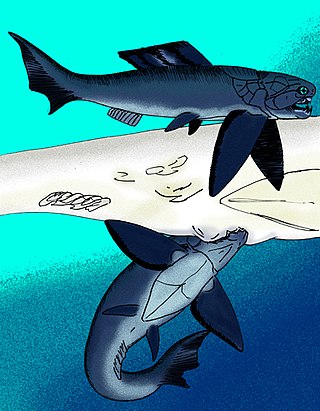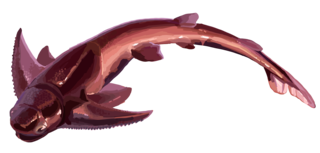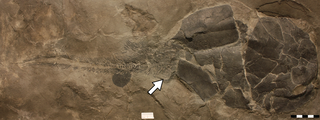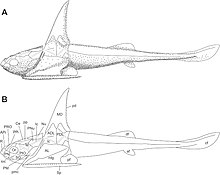
Placodermi is a class of armoured prehistoric fish, known from fossils, which lived from the Silurian to the end of the Devonian period. Their head and thorax were covered by articulated armoured plates and the rest of the body was scaled or naked, depending on the species. Placoderms were among the first jawed fish; their jaws likely evolved from the first of their gill arches.

Dunkleosteus is an extinct genus of large arthrodire ("jointed-neck") fish that existed during the Late Devonian period, about 382–358 million years ago. It was a pelagic fish inhabiting open waters, and one of the first apex predators of any ecosystem.

Arthrodira is an order of extinct armored, jawed fishes of the class Placodermi that flourished in the Devonian period before their sudden extinction, surviving for about 50 million years and penetrating most marine ecological niches. Arthrodires were the largest and most diverse of all groups of placoderms.

Groenlandaspis is an extinct genus of arthrodire from the Late Devonian. Fossils of the different species are found in late Devonian strata in all continents except eastern Asia. The generic name commemorates the fact that the first specimens of the type species were found in Greenland.

Coccosteus is an extinct genus of arthrodire placoderm from the Devonian period. Its fossils have been found throughout Europe and North America. The majority of these have been found in freshwater sediments, though such a large range suggests that they may have been able to enter saltwater. It was a small placoderm, with Coccosteus cuspidatus measuring 29.6–39.4 cm (11.7–15.5 in) long.

Titanichthys is an extinct genus of giant, aberrant marine placoderm from shallow seas of the Late Devonian of Morocco, Eastern North America, and possibly Europe. Many of the species approached Dunkleosteus in size and build. Unlike its relative, however, the various species of Titanichthys had small, ineffective-looking mouth-plates that lacked a sharp cutting edge. It is assumed that Titanichthys was a filter feeder that used its capacious mouth to swallow or inhale schools of small, anchovy-like fish, or possibly krill-like zooplankton, and that the mouth-plates retained the prey while allowing the water to escape as it closed its mouth. A study has since confirmed this assumption as its jaws are functionally closer to that of filter feeders like baleen whales and basking sharks, and it appears to have developed from benthic durophagists that became pelagic suspension feeders. This would make it the first (known) large-sized vertebrate filter feeder. Titanichthys was estimated to have reached a length of 7–7.6 m (23–25 ft), but Engelman (2023) suggested that Titanichthys was comparable in size to Dunkleosteus, likely measuring about or just over 4.1 metres (13.5 ft) in length.

Dinichthys is an extinct monospecific genus of large marine arthrodire placoderm from the Late Devonian measuring around 3 metres (9.8 ft) long. Fossils were recovered from the Ohio Shale Formation along the Olentangy River in Delaware County, Ohio.

Arctolepis is an extinct genus of placoderm arthrodire fish which lived during the Early Devonian period. Fossils of Arctolepis have been found in what is now Norway and Michigan.

Aleosteus is an extinct monospecific genus of arthrodire placoderm fish of the Early Devonian period. The type species Aleosteus eganensis was described in 2000, and was found in the Late Emsian strate of the Sevy Dolomite Formation, in the Egan Range of east-central Nevada, USA. Almost complete fossils belong to juvenile and adult specimens and show a short and broad skull, posteriorly concave.

Plourdosteus is an extinct genus of placoderm arthrodire which was relatively widespread in Euramerica during the Givetian to Frasnian ages of the Devonian. It was a small placoderm, with P. canadensis specimen MNHM 2-177 measuring 37.5 cm (14.8 in) long.

Mcnamaraspis is an extinct monospecific genus of arthrodire placoderm that inhabited the ancient reef system of north Western Australia during the Frasnian epoch of the Late Devonian period. The type specimen was found and described by John A. Long from the Gogo Formation near Fitzroy Crossing. This fossil fish showed new anatomical features in arthrodires, like the well-preserved annular (ring-shaped) cartilages of the snout, previously inferred to be present by Erik Stensiö of Sweden. It is occasionally referred to as "The Gogo Fish" after the locale the holotype was excavated from.

Wuttagoonaspis is a extinct genus of primitive arthrodire placoderm fish from the Middle Devonian of Australia. The box-like skull is up to 18 centimeters in length, and the median dorsal plate averages in length about 10 centimeters. It contains two species: the type species Wuttagoonaspis fletcheri, described by Ritchie in 1973, and Wuttagoonaspis milligani, described by Young and Goujet in 2003.
Heightingtonaspis is an extinct genus of primitive arthrodire placoderm from Canada, England and Wales with two species previously allied with the genus Kujdanowiaspis.

Kujdanowiaspis is an extinct genus of arthrodire placoderm fish from the Early Devonian of Podolia (Ukraine), Poland and Spain. Kujdanowiaspis is known from many fragmentary head shields and body armours.

Bungartius is an extinct genus of armoured, jawed fishes from the Late Devonian period of Ohio. Bungartius is thought to have been durophagous.

Millerosteus is an extinct genus of coccosteid arthrodire placoderm from the Early Givetian stage of the Middle Devonian period. Fossils are found in the Orkneys and Caithness, Scotland. It was a small placoderm with an body length of 14 cm (5.5 in). Millerosteus is one of the few arthrodires known from specimens preserving the entire skeleton.
Dickosteus is an extinct genus of coccosteid arthrodire placoderm from the Late Eifelian to Early Givetian stages of the Middle Devonian period. Fossils are found in the Orkneys and Caithness, Scotland. It was a small placoderm with a total body length of 43.7 cm (17.2 in). It is one of the few placoderms for which complete bodies are known.

Watsonosteus is an extinct genus of coccosteid arthrodire placoderm from the Late Givetian stage of the Middle Devonian period. Fossils are found in the Orkney Islands, Scotland. It was a small placoderm with a total body length of 57 cm (22 in), with the largest individuals reaching lengths of 1 m (39 in). It is one of the few arthrodires for which complete body fossils are known.

Amazichthys is an extinct genus of selenosteid arthrodire from the Middle Famennian of the Late Devonian of the Anti-Atlas Mountains of Morocco. It contains a single species, Amazichthys trinajsticae. It is one of a few example of placoderm known from whole body shape, including cartilaginous axial and fin elements.


























